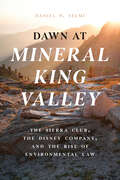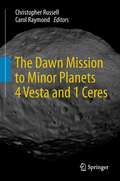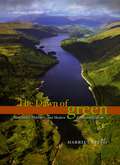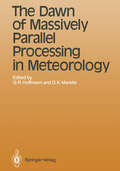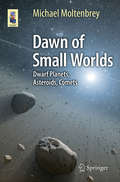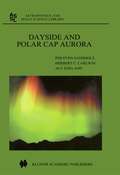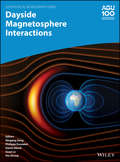- Table View
- List View
The Dawn Angiosperms: Uncovering the Origin of Flowering Plants (Lecture Notes in Earth Sciences #121)
by Xin WangAngiosperms are the most diversi ed plant group in the world, being represented by ca 300,000 species in about 400 families. Like all of Life, including ourselves, they have had their own history and gone through many evolutionary stages before they arrived at their current forms. The origin of Angiospermae ( owering plants) has been the subject of much dispute because this is a key event in the history of life, and has a far-reaching in uence on our understanding of relationships among seed plants as a whole as well as within the angiosperms. Until recently most of palae- otanists recognized angiosperms only from the Cretaceous and younger strata. This contradicts the results of molecular analyses. I have been working on Mesozoic fossil plants for the past two decades, during which time I have studied a number of fossil plants. Some of these fossil plants have been published as Jurassic angiosperms, and, unsurprisingly, many questions and doubts have been raised about them. These questions need to be addressed se- ously and journal papers do not provide suf cient space to compare and relate these early angiosperms. In this book these pioneer angiosperms are documented in detail, sometimes with new specimens not studied before. Also, I propose a de nition of angiosperms that could be adopted in palaeobotany. My aim is to improve clarity and objectivity of judgment about what constitutes a fossil angiosperm.
Dawn at Mineral King Valley: The Sierra Club, the Disney Company, and the Rise of Environmental Law
by Daniel P. SelmiThe story behind the historic Mineral King Valley case, which reveals how the Sierra Club battled Disney’s ski resort development and launched a new environmental era in America. In our current age of climate change–induced panic, it’s hard to imagine a time when private groups were not actively enforcing environmental protection laws in the courts. It wasn’t until 1972, however, that a David and Goliath–esque Supreme Court showdown involving the Sierra Club and Disney set a revolutionary legal precedent for the era of environmental activism we live in today. Set against the backdrop of the environmental movement that swept the country in the late 1960s and early 1970s, Dawn at Mineral King Valley tells the surprising story of how the US Forest Service, the Disney company, and the Sierra Club each struggled to adapt to the new, rapidly changing political landscape of environmental consciousness in postwar America. Proposed in 1965 and approved by the federal government in 1969, Disney’s vast development plan would have irreversibly altered the practically untouched Mineral King Valley, a magnificently beautiful alpine area in the Sierra Nevada mountains. At first, the plan met with unanimous approval from elected officials, government administrators, and the press—it seemed inevitable that this expanse of wild natural land would be radically changed and turned over to a private corporation. Then the scrappy Sierra Club forcefully pushed back with a lawsuit that ultimately propelled the modern environmental era by allowing interest groups to bring litigation against environmentally destructive projects. An expert on environmental law and appellate advocacy, Daniel P. Selmi uses his authoritative narrative voice to recount the complete history of this revolutionary legal battle and the ramifications that continue today, almost 50 years later.
Dawn at Mineral King Valley: The Sierra Club, the Disney Company, and the Rise of Environmental Law
by Daniel P. SelmiThe story behind the historic Mineral King Valley case, which reveals how the Sierra Club battled Disney’s ski resort development and launched a new environmental era in America. In our current age of climate change–induced panic, it’s hard to imagine a time when private groups were not actively enforcing environmental protection laws in the courts. It wasn’t until 1972, however, that a David and Goliath–esque Supreme Court showdown involving the Sierra Club and Disney set a revolutionary legal precedent for the era of environmental activism we live in today. Set against the backdrop of the environmental movement that swept the country in the late 1960s and early 1970s, Dawn at Mineral King Valley tells the surprising story of how the US Forest Service, the Disney company, and the Sierra Club each struggled to adapt to the new, rapidly changing political landscape of environmental consciousness in postwar America. Proposed in 1965 and approved by the federal government in 1969, Disney’s vast development plan would have irreversibly altered the practically untouched Mineral King Valley, a magnificently beautiful alpine area in the Sierra Nevada mountains. At first, the plan met with unanimous approval from elected officials, government administrators, and the press—it seemed inevitable that this expanse of wild natural land would be radically changed and turned over to a private corporation. Then the scrappy Sierra Club forcefully pushed back with a lawsuit that ultimately propelled the modern environmental era by allowing interest groups to bring litigation against environmentally destructive projects. An expert on environmental law and appellate advocacy, Daniel P. Selmi uses his authoritative narrative voice to recount the complete history of this revolutionary legal battle and the ramifications that continue today, almost 50 years later.
Dawn-Dusk Asymmetries in Planetary Plasma Environments (Geophysical Monograph Series #230)
by Stein Haaland Andrei Runov Colin ForsythDawnDusk Asymmetries in Planetary Plasma Environments Dawn-dusk asymmetries are ubiquitous features of the plasma environment of many of the planets in our solar system. They occur when a particular process or feature is more pronounced at one side of a planet than the other. For example, recent observations indicate that Earth's magnetopause is thicker at dawn than at dusk. Likewise, auroral breakups at Earth are more likely to occur in the pre-midnight than post-midnight sectors. Increasing availability of remotely sensed and in situ measurements of planetary ionospheres, magnetospheres and their interfaces to the solar wind have revealed significant and persistent dawn-dusk asymmetries. As yet there is no consensus regarding the source of many of these asymmetries, nor the physical mechanisms by which they are produced and maintained. Volume highlights include: A comprehensive and updated overview of current knowledge about dawn-dusk asymmetries in the plasma environments of planets in our solar system and the mechanisms behind them Valuable contributions from internationally recognized experts, covering both observations, simulations and theories discussing all important aspects of dawn-dusk asymmetries Space weather effects are caused by processes in space, mainly the magnetotail, and can be highly localized on ground. Knowing where the source, i.e., where dawn-dusk location is will allow for a better prediction of where the effects on ground will be most pronounced Covering both observational and theoretical aspects of dawn dusk asymmetries, Dawn-Dusk Asymmetries in Planetary Plasma Environments will be a valuable resource for academic researchers in space physics, planetary science, astrophysics, physics, geophysics and earth science.
Dawn-Dusk Asymmetries in Planetary Plasma Environments (Geophysical Monograph Series #230)
by Stein Haaland Andrei Runov Colin ForsythDawnDusk Asymmetries in Planetary Plasma Environments Dawn-dusk asymmetries are ubiquitous features of the plasma environment of many of the planets in our solar system. They occur when a particular process or feature is more pronounced at one side of a planet than the other. For example, recent observations indicate that Earth's magnetopause is thicker at dawn than at dusk. Likewise, auroral breakups at Earth are more likely to occur in the pre-midnight than post-midnight sectors. Increasing availability of remotely sensed and in situ measurements of planetary ionospheres, magnetospheres and their interfaces to the solar wind have revealed significant and persistent dawn-dusk asymmetries. As yet there is no consensus regarding the source of many of these asymmetries, nor the physical mechanisms by which they are produced and maintained. Volume highlights include: A comprehensive and updated overview of current knowledge about dawn-dusk asymmetries in the plasma environments of planets in our solar system and the mechanisms behind them Valuable contributions from internationally recognized experts, covering both observations, simulations and theories discussing all important aspects of dawn-dusk asymmetries Space weather effects are caused by processes in space, mainly the magnetotail, and can be highly localized on ground. Knowing where the source, i.e., where dawn-dusk location is will allow for a better prediction of where the effects on ground will be most pronounced Covering both observational and theoretical aspects of dawn dusk asymmetries, Dawn-Dusk Asymmetries in Planetary Plasma Environments will be a valuable resource for academic researchers in space physics, planetary science, astrophysics, physics, geophysics and earth science.
The Dawn Mission to Minor Planets 4 Vesta and 1 Ceres
by Christopher Russell Carol RaymondDawn is the first mission to orbit a main belt asteroid and the first scientific mission to use ion propulsion. Major objectives of this mission include mapping of the surfaces of 4 Vesta and 1 Ceres, determining its topography from stereo measurements, determining its mineralogy, measuring its elemental composition and obtaining gravity data. This book describes the Dawn mission, its exploration and scientific objectives, the instruments that accomplish those objectives, the operations plan and the education and outreach plan. It is directed to those studying asteroids and the evolution of the solar system. This volume will be a valuable reference for anyone who uses data from the instruments of the DAWN mission. Previously published in Space Science Reviews, Vol. 163/1-4, 2012.
The Dawn of Green: Manchester, Thirlmere, and Modern Environmentalism
by Harriet RitvoLocated in the heart of England’s Lake District, the placid waters of Thirlmere seem to be the embodiment of pastoral beauty. But under their calm surface lurks the legacy of a nineteenth-century conflict that pitted industrial progress against natural conservation—and helped launch the environmental movement as we know it. Purchased by the city of Manchester in the 1870s, Thirlmere was dammed and converted into a reservoir, its water piped one hundred miles south to the burgeoning industrial city and its workforce. This feat of civil engineering—and of natural resource diversion—inspired one of the first environmental struggles of modern times. The Dawn of Green re-creates the battle for Thirlmere and the clashes between conservationists who wished to preserve the lake and developers eager to supply the needs of a growing urban population. Bringing to vivid life the colorful and strong-minded characters who populated both sides of the debate, noted historian Harriet Ritvo revisits notions of the natural promulgated by romantic poets, recreationists, resource managers, and industrial developers to establish Thirlmere as the template for subsequent—and continuing—environmental struggles.
The Dawn of Green: Manchester, Thirlmere, and Modern Environmentalism
by Harriet RitvoLocated in the heart of England’s Lake District, the placid waters of Thirlmere seem to be the embodiment of pastoral beauty. But under their calm surface lurks the legacy of a nineteenth-century conflict that pitted industrial progress against natural conservation—and helped launch the environmental movement as we know it. Purchased by the city of Manchester in the 1870s, Thirlmere was dammed and converted into a reservoir, its water piped one hundred miles south to the burgeoning industrial city and its workforce. This feat of civil engineering—and of natural resource diversion—inspired one of the first environmental struggles of modern times. The Dawn of Green re-creates the battle for Thirlmere and the clashes between conservationists who wished to preserve the lake and developers eager to supply the needs of a growing urban population. Bringing to vivid life the colorful and strong-minded characters who populated both sides of the debate, noted historian Harriet Ritvo revisits notions of the natural promulgated by romantic poets, recreationists, resource managers, and industrial developers to establish Thirlmere as the template for subsequent—and continuing—environmental struggles.
The Dawn of Green: Manchester, Thirlmere, and Modern Environmentalism
by Harriet RitvoLocated in the heart of England’s Lake District, the placid waters of Thirlmere seem to be the embodiment of pastoral beauty. But under their calm surface lurks the legacy of a nineteenth-century conflict that pitted industrial progress against natural conservation—and helped launch the environmental movement as we know it. Purchased by the city of Manchester in the 1870s, Thirlmere was dammed and converted into a reservoir, its water piped one hundred miles south to the burgeoning industrial city and its workforce. This feat of civil engineering—and of natural resource diversion—inspired one of the first environmental struggles of modern times. The Dawn of Green re-creates the battle for Thirlmere and the clashes between conservationists who wished to preserve the lake and developers eager to supply the needs of a growing urban population. Bringing to vivid life the colorful and strong-minded characters who populated both sides of the debate, noted historian Harriet Ritvo revisits notions of the natural promulgated by romantic poets, recreationists, resource managers, and industrial developers to establish Thirlmere as the template for subsequent—and continuing—environmental struggles.
The Dawn of Green: Manchester, Thirlmere, and Modern Environmentalism
by Harriet RitvoLocated in the heart of England’s Lake District, the placid waters of Thirlmere seem to be the embodiment of pastoral beauty. But under their calm surface lurks the legacy of a nineteenth-century conflict that pitted industrial progress against natural conservation—and helped launch the environmental movement as we know it. Purchased by the city of Manchester in the 1870s, Thirlmere was dammed and converted into a reservoir, its water piped one hundred miles south to the burgeoning industrial city and its workforce. This feat of civil engineering—and of natural resource diversion—inspired one of the first environmental struggles of modern times. The Dawn of Green re-creates the battle for Thirlmere and the clashes between conservationists who wished to preserve the lake and developers eager to supply the needs of a growing urban population. Bringing to vivid life the colorful and strong-minded characters who populated both sides of the debate, noted historian Harriet Ritvo revisits notions of the natural promulgated by romantic poets, recreationists, resource managers, and industrial developers to establish Thirlmere as the template for subsequent—and continuing—environmental struggles.
The Dawn of Green: Manchester, Thirlmere, and Modern Environmentalism
by Harriet RitvoLocated in the heart of England’s Lake District, the placid waters of Thirlmere seem to be the embodiment of pastoral beauty. But under their calm surface lurks the legacy of a nineteenth-century conflict that pitted industrial progress against natural conservation—and helped launch the environmental movement as we know it. Purchased by the city of Manchester in the 1870s, Thirlmere was dammed and converted into a reservoir, its water piped one hundred miles south to the burgeoning industrial city and its workforce. This feat of civil engineering—and of natural resource diversion—inspired one of the first environmental struggles of modern times. The Dawn of Green re-creates the battle for Thirlmere and the clashes between conservationists who wished to preserve the lake and developers eager to supply the needs of a growing urban population. Bringing to vivid life the colorful and strong-minded characters who populated both sides of the debate, noted historian Harriet Ritvo revisits notions of the natural promulgated by romantic poets, recreationists, resource managers, and industrial developers to establish Thirlmere as the template for subsequent—and continuing—environmental struggles.
The Dawn of Green: Manchester, Thirlmere, and Modern Environmentalism
by Harriet RitvoLocated in the heart of England’s Lake District, the placid waters of Thirlmere seem to be the embodiment of pastoral beauty. But under their calm surface lurks the legacy of a nineteenth-century conflict that pitted industrial progress against natural conservation—and helped launch the environmental movement as we know it. Purchased by the city of Manchester in the 1870s, Thirlmere was dammed and converted into a reservoir, its water piped one hundred miles south to the burgeoning industrial city and its workforce. This feat of civil engineering—and of natural resource diversion—inspired one of the first environmental struggles of modern times. The Dawn of Green re-creates the battle for Thirlmere and the clashes between conservationists who wished to preserve the lake and developers eager to supply the needs of a growing urban population. Bringing to vivid life the colorful and strong-minded characters who populated both sides of the debate, noted historian Harriet Ritvo revisits notions of the natural promulgated by romantic poets, recreationists, resource managers, and industrial developers to establish Thirlmere as the template for subsequent—and continuing—environmental struggles.
The Dawn of Massively Parallel Processing in Meteorology: Proceedings of the 3rd Workshop on Use of Parallel Processors in Meteorology (Topics in Atmospheric and Oceanic Sciences)
by Dimitris K. Maretis Geerd R. HoffmannThe Dawn of Massively Parallel Processing in Meteorology presents collected papers of the third workshop on this topic held at the European Centre of Medium-Range Weather Forecasts (ECMWF). It provides an insight into the state of the art in using parallel processors operationally, and allows extrapolation to other time-critical applications. It also documents the advent of massively parallel systems to cope with these applications.
Dawn of Small Worlds: Dwarf Planets, Asteroids, Comets (Astronomers' Universe)
by Michael MoltenbreyThis book gives a detailed introduction to the thousands and thousands of smaller bodies in the solar system. Written for interested laymen, amateur astronomers and students it describes the nature and origin of asteroids, dwarf planets and comets, and gives detailed information about their role in the solar system. The author nicely reviews the history of small-world-exploration and describes past, current and future space craft missions studying small worlds, and presents their results. Readers will learn that small solar system worlds have a dramatically different nature and appearance than the planets. Even though research activity on small worlds has increased in the recent past many of their properties are still in the dark and need further research.
DAX-Firms and Human Rights: Understanding Institutional and Stakeholder Pressures along the Value Chain
by Carlo Manuel DrauthCarlo Manuel Drauth explores under which conditions multinational enterprises systematically manage their human rights impacts with a view to preventing corporate human rights violations across their operations. Using a multi-method research design and focusing on the 30 largest German firms, the author finds that it is neither institutional forces (e.g., standards or norms) nor stakeholder pressures (e.g., from NGOs or trade unions) alone, but their combined effect that leads to a systematic human rights management at the firm-level. This finding informs a new theoretical approach to the study of CSR, integrating institutional and stakeholder theories while taking an explicit value chain perspective.
Day and Night: Level 2 (National Geographic Readers Ser.)
by Shira Evans National Geographic KidsNational Geographic Primary Readers is a high-interest series of beginning reading books that have been developed in consultation with education experts. The books pair magnificent National Geographic photographs with lively text by skilled children’s book authors across four reading levels. Learn how animals and plants change and adapt to day and night in this photographic non-fiction book. Level 2: Becoming fluent. These books are a good match for kids who are developing reading stamina and enjoy a longer book. They are ideal for readers of Green, Orange and Turquoise books.
The Day the World Stops Shopping: How ending consumerism gives us a better life and a greener world
by J. B. MacKinnonWe can't stop shopping but we must stop shopping - the consumer dilemma that defines our lives and our future. What would happen if we did?We are using up the planet at almost double the rate it can regenerate. To support our economies, we're told we must shop now like we've never shopped before. And whilst we can do it more responsibly, the scale of our consumption remains the biggest factor in the ruination of the planet. Yet our reliance on stuff continues to grow. But what would our world look like if we stopped? Would civilisation collapse? Would the planet's ecology be reborn? What would happen to the way we think, make products, use time, express our individuality? Would life be better - or worse?Visiting places where economies have experienced temporary shut-downs, artisan producers, zero-consumption societies and bringing together a host of expert views, this is both a deeply reported thought-experiment, a history of our relationship with consumption, and a story about the future.Our private choices are putting the world in peril. The Day the World Stops Shopping is an essential exploration of who we are and what we use, and a vision of a more sustainable world.
Daylighting and Integrated Lighting Design (PocketArchitecture)
by Christopher Meek Kevin Van WymelenbergDaylighting and Integrated Lighting Design provides architects, building designers, and students clear direction for the successful inclusion of daylight and integrated electric light in buildings. It presents design teams with the performance analysis resources, energy saving estimates and user satisfaction results they need in order to make informed decisions regarding daylighting and lighting design. Written by two well-known experts in the field, the book provides: critical geometric and material relationships along with proven design process activities, offered in a quick-reference format, with sufficient context to address the range of associated issues present in any building project both the "fundamentals" and "applications" which cover design concepts and practice activities applicable to all integrated lighting projects specific directives for how the concepts covered are applied in a range of common design scenarios, including architectural rules-of-thumb, instructions for ensuring visual comfort, and preferred approaches for electric lighting control integration. In demonstrating these necessary insights to designers, the authors employ an iterative analysis of common "daylighting patterns" and illustrate and annotate both successful and unsuccessful examples via built form and simulation. Part of the PocketArchitecture series, this is the ideal pocketbook for any designer serious about reducing the energy impact of their buildings.
Daylighting and Integrated Lighting Design (PocketArchitecture)
by Christopher Meek Kevin Van WymelenbergDaylighting and Integrated Lighting Design provides architects, building designers, and students clear direction for the successful inclusion of daylight and integrated electric light in buildings. It presents design teams with the performance analysis resources, energy saving estimates and user satisfaction results they need in order to make informed decisions regarding daylighting and lighting design. Written by two well-known experts in the field, the book provides: critical geometric and material relationships along with proven design process activities, offered in a quick-reference format, with sufficient context to address the range of associated issues present in any building project both the "fundamentals" and "applications" which cover design concepts and practice activities applicable to all integrated lighting projects specific directives for how the concepts covered are applied in a range of common design scenarios, including architectural rules-of-thumb, instructions for ensuring visual comfort, and preferred approaches for electric lighting control integration. In demonstrating these necessary insights to designers, the authors employ an iterative analysis of common "daylighting patterns" and illustrate and annotate both successful and unsuccessful examples via built form and simulation. Part of the PocketArchitecture series, this is the ideal pocketbook for any designer serious about reducing the energy impact of their buildings.
Days to Remember: Adventures and reflections of a mountain guide
by Rob CollisterDays to Remember is a collection of tales from well-known mountain guide Rob Collister – tales of long days on the hill, travelling fast and light, often alone, and always steering well clear of the honeypots. From day trips around his local hills in Wales, to worldwide expeditions including the Silvretta Alps, Gletscherhorn, the Cordillera Blanca and Annapurna, Rob Collister enjoys covering ground under his own steam, whether it be walking, running, climbing, cycling or skiing. With a foreword from renowned British mountaineer and writer Stephen Venables, this collection of essays communicates Collister’s connection with the history of the landscapes he explores, while demonstrating knowledge and appreciation of the flora and fauna that thrive there today. In Days to Remember we are reminded of the fragility of our natural environment and the importance of investing in its preservation, at the same time as being captivated by the beautiful images Collister evokes with his mountain tales. This book will leave you with expanded understanding of contemporary environmental issues and a renewed hunger for days in the hills.
Dayside and Polar Cap Aurora (Astrophysics and Space Science Library #270)
by Per Even Sandholt H.C. Carlson A. EgelandThe auroral emissions in the upper atmosphere of the polar regions of the Earth are evidence of the capture of energetic particles from the Sun, streaming by the Earth as the solar wind. These auroral emissions, then, are a window to outer space, and can provide us with valuable information about electrodynamic coupling processes between the solar wind and the Earth's ionosphere and upper atmosphere. Studying the physics of these phenomena extends our understanding of our plasma universe. Ground-based remote-sensing techniques, able to monitor continuously the variations in the signatures of aurorae, in combination with in-situ satellite and rocket measurements, promise to advance dramatically our understanding of the physical processes taking place at the interface of the atmospheres of the Earth and the Sun. Decoding their complexity brings us closer to reliable prediction of communication environments, especially at high latitudes. This understanding, in turn, will help us resolve problems of communication and navigation across polar regions.
Dayside Magnetosphere Interactions (Geophysical Monograph Series #249)
by Qiugang Zong Philippe Escoubet David Sibeck Guan Le Hui ZhangExploring the processes and phenomena of Earth’s dayside magnetosphere Energy and momentum transfer, initially taking place at the dayside magnetopause, is responsible for a variety of phenomenon that we can measure on the ground. Data obtained from observations of Earth’s dayside magnetosphere increases our knowledge of the processes by which solar wind mass, momentum, and energy enter the magnetosphere. Dayside Magnetosphere Interactions outlines the physics and processes of dayside magnetospheric phenomena, the role of solar wind in generating ultra-low frequency waves, and solar wind-magnetosphere-ionosphere coupling. Volume highlights include: Phenomena across different temporal and spatial scales Discussions on dayside aurora, plume dynamics, and related dayside reconnection Results from spacecraft observations, ground-based observations, and simulations Discoveries from the Magnetospheric Multiscale Mission and Van Allen Probes era Exploration of foreshock, bow shock, magnetosheath, magnetopause, and cusps Examination of similar processes occurring around other planets The American Geophysical Union promotes discovery in Earth and space science for the benefit of humanity. Its publications disseminate scientific knowledge and provide resources for researchers, students, and professionals.
Dayside Magnetosphere Interactions (Geophysical Monograph Series #249)
by Quigang Zong Philippe Escoubet David Sibeck Guan Le Hui ZhangExploring the processes and phenomena of Earth’s dayside magnetosphere Energy and momentum transfer, initially taking place at the dayside magnetopause, is responsible for a variety of phenomenon that we can measure on the ground. Data obtained from observations of Earth’s dayside magnetosphere increases our knowledge of the processes by which solar wind mass, momentum, and energy enter the magnetosphere. Dayside Magnetosphere Interactions outlines the physics and processes of dayside magnetospheric phenomena, the role of solar wind in generating ultra-low frequency waves, and solar wind-magnetosphere-ionosphere coupling. Volume highlights include: Phenomena across different temporal and spatial scales Discussions on dayside aurora, plume dynamics, and related dayside reconnection Results from spacecraft observations, ground-based observations, and simulations Discoveries from the Magnetospheric Multiscale Mission and Van Allen Probes era Exploration of foreshock, bow shock, magnetosheath, magnetopause, and cusps Examination of similar processes occurring around other planets The American Geophysical Union promotes discovery in Earth and space science for the benefit of humanity. Its publications disseminate scientific knowledge and provide resources for researchers, students, and professionals.
Daytime and Night-time Sea Breezes (large print)
by RnibThis page has two diagrams of daytime and night-time sea breezes shown in cross section (from the side) and stretching across the width of the page: one at the top and one at the bottom. There is a locator dot shown, which will be at the top left of the page when the image is the right way up. A dashed line image border surrounds each diagram. Daytime sea breezes (1): The diagram at the top of the page shows an area of land at the left, sloping right and down to a section of sea, starting at the bottom centre of the diagram. Above the land on the left are two wiggly lines with arrowheads and up the page from these are a line of arrows pointing to the right, then down, then back to the left, showing the onshore cool breeze. At the top right of the page are three thick arrows pointing down and left diagonally, representing the sun's energy. There are text labels on the diagram that describe the features and processes shown. Night-time sea breezes (2): The diagram at the bottom of the page shows an area of land at the left, sloping right and down to a section of sea, starting at the bottom centre of the diagram. Above the sea on the right are two wiggly lines with arrowheads and up the page from these are a line of arrows pointing to the left, then down, then back to the right, showing the offshore breeze. There are text labels on the diagram, that describe the features and processes shown.
Daytime and Night-time Sea Breezes (UEB contracted)
by RnibThis page has two diagrams of daytime and night-time sea breezes shown in cross section (from the side) and stretching across the width of the page: one at the top and one at the bottom. There is a locator dot shown, which will be at the top left of the page when the image is the right way up. A dashed line image border surrounds each diagram. Daytime sea breezes (1): The diagram at the top of the page shows an area of land at the left, sloping right and down to a section of sea, starting at the bottom centre of the diagram. Above the land on the left are two wiggly lines with arrowheads and up the page from these are a line of arrows pointing to the right, then down, then back to the left, showing the onshore cool breeze. At the top right of the page are three thick arrows pointing down and left diagonally, representing the sun's energy. There are text labels on the diagram that describe the features and processes shown. Night-time sea breezes (2): The diagram at the bottom of the page shows an area of land at the left, sloping right and down to a section of sea, starting at the bottom centre of the diagram. Above the sea on the right are two wiggly lines with arrowheads and up the page from these are a line of arrows pointing to the left, then down, then back to the right, showing the offshore breeze. There are text labels on the diagram, which describe the features and processes shown.

